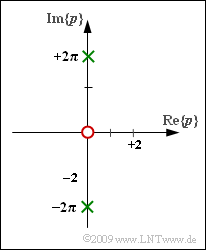Difference between revisions of "Aufgaben:Exercise 3.6Z: Two Imaginary Poles"
From LNTwww
| Line 74: | Line 74: | ||
===Solution=== | ===Solution=== | ||
{{ML-Kopf}} | {{ML-Kopf}} | ||
| − | '''(1)''' | + | '''(1)''' The <u>suggested solutions 1, 3 and 4</u> are correct: |
| − | * | + | *The following is obtained for signal $x(t)$ for positive times by applying the residue theorem: |
:$$x_1(t)\hspace{0.25cm} = \hspace{0.2cm} {\rm Res} \bigg |_{p \hspace{0.05cm}= \hspace{0.05cm}p_{{\rm x}1}} | :$$x_1(t)\hspace{0.25cm} = \hspace{0.2cm} {\rm Res} \bigg |_{p \hspace{0.05cm}= \hspace{0.05cm}p_{{\rm x}1}} | ||
\hspace{0.7cm}\{X_{\rm L}(p)\cdot {\rm e}^{\hspace{0.05cm}p \hspace{0.05cm}\cdot \hspace{0.05cm}t}\}= | \hspace{0.7cm}\{X_{\rm L}(p)\cdot {\rm e}^{\hspace{0.05cm}p \hspace{0.05cm}\cdot \hspace{0.05cm}t}\}= | ||
Revision as of 08:54, 25 October 2021
In this exercise, we consider a causal signal $x(t)$ with the Laplace transform
- $$X_{\rm L}(p) = \frac { p} { p^2 + 4 \pi^2}= \frac { p} { (p-{\rm j} \cdot 2\pi)(p+{\rm j} \cdot 2\pi)} \hspace{0.05cm}$$
corresponding to the graph (one red zero and two green poles).
In contrast, the signal $y(t)$ has the Laplace spectral function
- $$Y_{\rm L}(p) = \frac { 1} { p^2 + 4 \pi^2} \hspace{0.05cm}.$$
Thus, the red zero does not belong to $Y_{\rm L}(p)$.
Finally, the signal $z(t)$ with the Laplace tansform
- $$Z_{\rm L}(p) = \frac { p} { (p-{\rm j} \cdot \beta)(p+{\rm j} \cdot \beta)} \hspace{0.05cm}$$
is considered, in particular the limiting case for $\beta → 0$.
Please note:
- The exercise belongs to the chapter Inverse Laplace Transform.
- The frequency variable $p$ is normalized such that time $t$ is in microseconds after applying the residue theorem.
- A result $t = 1$ is thus to be interpreted as $t = T$ with $T = 1 \ \rm µ s$ .
- The residue theorem is as follows using the example of the function $X_{\rm L}(p)$ with two simple poles at $ \pm {\rm j} \cdot \beta$:
- $$x(t) = X_{\rm L}(p) \cdot (p - {\rm j} \cdot \beta) \cdot {\rm e}^{\hspace{0.03cm}p\hspace{0.05cm} \cdot \hspace{0.05cm}t} \Bigg |_{\hspace{0.1cm} p\hspace{0.05cm}=\hspace{0.05cm}{\rm j \hspace{0.05cm} \cdot\hspace{0.05cm} \it \beta}}+X_{\rm L}(p) \cdot (p + {\rm j} \cdot \beta) \cdot {\rm e}^{\hspace{0.03cm}p \hspace{0.05cm} \cdot\hspace{0.05cm}t} \Bigg |_{\hspace{0.1cm} p\hspace{0.05cm}=\hspace{0.05cm}{-\rm j \hspace{0.05cm} \cdot\hspace{0.05cm} \it \beta}} \hspace{0.05cm}.$$
Questions
Solution
(1) The suggested solutions 1, 3 and 4 are correct:
- The following is obtained for signal $x(t)$ for positive times by applying the residue theorem:
- $$x_1(t)\hspace{0.25cm} = \hspace{0.2cm} {\rm Res} \bigg |_{p \hspace{0.05cm}= \hspace{0.05cm}p_{{\rm x}1}} \hspace{0.7cm}\{X_{\rm L}(p)\cdot {\rm e}^{\hspace{0.05cm}p \hspace{0.05cm}\cdot \hspace{0.05cm}t}\}= \frac {p} { p+{\rm j} \cdot 2\pi}\cdot {\rm e}^{\hspace{0.05cm}p \hspace{0.05cm}\cdot \hspace{0.05cm}t} \bigg |_{p \hspace{0.05cm}= \hspace{0.05cm}{\rm j} \hspace{0.05cm}\cdot \hspace{0.05cm}2\pi}= \frac{1}{2} \cdot {\rm e}^{\hspace{0.05cm}{\rm j} \hspace{0.05cm} \cdot \hspace{0.05cm}2\pi t}\hspace{0.05cm} ,$$
- $$ x_2(t)\hspace{0.25cm} = \hspace{0.2cm} {\rm Res} \bigg |_{p \hspace{0.05cm}= \hspace{0.05cm}p_{{\rm x}2}} \hspace{0.7cm}\{X_{\rm L}(p)\cdot {\rm e}^{\hspace{0.05cm}p \hspace{0.05cm}\cdot \hspace{0.05cm} t}\}= \frac {p} { p-{\rm j} \cdot 2\pi}\cdot {\rm e}^{\hspace{0.05cm}p \hspace{0.05cm}\cdot \hspace{0.05cm}t} \bigg |_{p \hspace{0.05cm}= -{\rm j} \hspace{0.05cm}\cdot \hspace{0.05cm}2\pi}= \frac{1}{2} \cdot {\rm e}^{-{\rm j} \hspace{0.05cm} \cdot \hspace{0.05cm}2\pi t} \hspace{0.05cm} .$$
- $$\Rightarrow \hspace{0.3cm} x(t) = x_1(t) + x_2(t) = {1}/{2} \cdot \left [ {\rm e}^{\hspace{0.05cm}{\rm j} \hspace{0.05cm} \cdot \hspace{0.05cm}2\pi t}+{\rm e}^{-{\rm j} \hspace{0.05cm} \cdot \hspace{0.05cm}2\pi t}\right ] = \cos(2\pi t) \hspace{0.05cm} .$$
(2) Richtig sind die Lösungsvorschläge 2 und 4:
- Prinzipiell könnte diese Teilaufgabe in gleicher Weise gelöst werden wie die Teilaufgabe (1).
- Man kann aber auch den Integrationssatz heranziehen.
- Dieser besagt unter anderem, dass die Multiplikation mit $1/p$ im Spektralbereich der Integration im Zeitbereich entspricht:
- $$Y_{\rm L}(p) = {1}/{p} \cdot X_{\rm L}(p) \hspace{0.3cm} \Rightarrow \hspace{0.3cm} t \ge 0:\quad y(t) = \int_{-\infty}^t \cos(2\pi \tau)\,\,{\rm d}\tau = {1}/({2\pi}) \cdot \sin(2\pi t) \hspace{0.05cm} .$$
Hinweis: Das kausale Cosinussignal $x(t)$ sowie das kausale Sinussignal $y(t)$ sind auf dem Angabenblatt zu Aufgabe 3.6 als $c_{\rm K}(t)$ bzw. $s_{\rm K}(t)$ dargestellt.
(3) Richtig sind die Lösungsvorschläge 1 und 3:
- Ein Vergleich mit der Berechnung von $x(t)$ zeigt, dass $z(t) = \cos (\beta \cdot t)$ für $t \ge 0$ und $z(t) = 0$ für $t < 0$ gilt.
- Der Grenzübergang für $\beta → 0$ führt damit zur Sprungfunktion $\gamma(t)$.
- Zum gleichen Ergebnis kommt man durch die Betrachtung im Spektralbereich:
- $$Z_{\rm L}(p) = \lim_{\beta \hspace{0.05cm} \rightarrow \hspace{0.05cm} 0}\hspace{0.1cm}\frac{p}{p^2 + \beta^2} = {1}/{p} \hspace{0.3cm} \Rightarrow \hspace{0.3cm} z(t) = \gamma(t) \hspace{0.05cm} .$$
